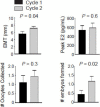Ozone sauna therapy and pulsed electromagnetic field therapy could potentially improve outcome in women with diminished ovarian reserve undergoing assisted reproductive technology
- PMID: 37077119
- PMCID: PMC10226693
- DOI: 10.4103/2045-9912.350862
Ozone sauna therapy and pulsed electromagnetic field therapy could potentially improve outcome in women with diminished ovarian reserve undergoing assisted reproductive technology
Abstract
There are limited treatment options for women with severely diminished ovarian reserve (DOR) who experience repeatedly failed in vitro fertilization (IVF) cycles and with persistently thin endometrial lining thickness (EMT) during frozen embryo transfer cycles. Therefore, a large majority of patients resort to using donor oocytes and gestational carriers. Data from existing animal and human studies suggest that ozone sauna therapy (OST) and pulsed electromagnetic field therapy (PEMF) are emerging as potential therapeutic adjuncts for female reproduction. This study was conducted to assess the fertility outcome of OST + PEMF in vivo in patients undergoing IVF/frozen embryo transfe and the effects of OST in vitro on human granulosa cell (GC) function. Forty-four women with DOR underwent their 1st IVF cycle (Cycle 1), and then were administered transdermal and intravaginal OST + PEMF, twice a week for 3 weeks, followed by a 2nd IVF cycle (Cycle 2) using the same protocol as in Cycle 1. GCs collected from another six women who underwent egg retrieval were equally split and cultured with OST (test) or placed in room temperature (control) outside the OST chamber in the same room. The results demonstrated that Cycles 1 and 2 had no significant difference in the number of days of stimulation, baseline hormones measured, number of oocytes retrieved or peak estradiol levels. However, the number of embryos formed after OST + PEMF in Cycle 2 was significantly higher than the Cycle 1. Furthermore, EMT measured in Cycle 2 demonstrated a significant increase compared to Cycle 1 and all patients reached a satisfactory EMT of approximately 7 mm. In vitro studies demonstrated that OST led to a 5-fold significant increase in the aromatase enzyme while a significant 50% reduction was noted in the side-chain cleavage enzyme in GCs. Both OST + PEMF are known for their vasodilatory, anti-inflammatory, and antioxidant actions, which could enhance endometrial receptivity and increase the number of formed embryos without increasing the number of oocytes retrieved, suggesting an improvement in oocyte quality. Finally, ozone can alter genes involved in steroidogenesis suggesting that it could improve ovarian function.
Keywords: diminished ovarian reserve; endometrial lining thickness; fertilization; granulosa cells; in vitro; oocyte; ozone sauna therapy; pulsed electromagnetic field therapy; steroidogenesis.
Conflict of interest statement
None
Figures


References
-
- Nogales CG, Ferrari PH, Kantorovich EO, Lage-Marques JL. Ozone therapy in medicine and dentistry. J Contemp Dent Pract. 2008;9:75–84. - PubMed
MeSH terms
Substances
LinkOut - more resources
Full Text Sources
Medical
Miscellaneous

